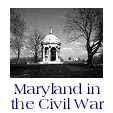

Harry Gilmor was tall, handsome, a polite gentleman, a ladies man, a member of Maryland's high society, and as personnaly brave as "William Wallace" of Scottish lore. He was also extremely conceited and full of self assurance. These ingredients made him one of the most dashing, cavalier horsemen of the war. He collected around him a wood-be band of Robin Hoods who mirrored his own personal traits.
A member of the Towson Guards or Baltimore Horse Guards, and somewhat voiceverous in his political opinions, Gilmor found himself a guest of the Federal government at Fort McHenry, when the war errupted. After his release he made his way to the Shenandoah, where he served as a scout for Colonel turner Ashby, JEB Stuart's predecessor. Private Gilmor was soon promoted to Sergeant Major, and by March of 1862 he had raised his own comapny, which was attached to the 12th Virginia Cavalry.
Gilmor was with Stonewall Jackson at McDowell in May of 1862. After the battle he was directed to follow Milroy and round up stragglers. Afterwards he was directed to find and watch General Fremont. When Fremont began his movement to come in behind Jackson while Jackson was busy dealing wth Shields at the northern end of the Valley, Gilmor alerted Jackson. This information allowed Jackson to change his plans, move to the east fork of the Shennandoah, where he defeated Shields at Cross Keys on June 8th, and Fremont on at Port Republic on June 9th.
Gilmor's Company spent the next three months scouting, serving as couriers and harrassing enemy camps and trains. True to form, when Jackson's column crossed the Potomac into Maryland in September of 1862, Gilmor, expecting the Federal army to be slow to react to Lee's invasion, took "French Leave," to see his family in Towson, Maryland, just north of Baltimore. He and a companion managed to ride to within seven miles of Glen Ellen, Gilmor's family home. It was late, so the two riders decided to spend the night at a friends home. Unknown to them, a Federal patrol was on it's way to the friend's home to look for contraband and supplies moving South. As a consequence, Gilmor found himself once again a guest of the Federal government.
Exchanged sometime later, Gilmor aligned himself with JEB Stuart, and was at his side during the Battle of Kelly's Ford in March of 1863. But it wasn't long before he petitioned to raise his own regiment of cavalry. In April of 1862 the Confederate Congress had passed an act authorizing the creation of partisan groups to operate independently of established military field commands. This type of operation fit Gilmor's character perfectly. He began to organize several companies consisting mostly of Marylanders. "The Band," as they commonly called themselves, were a rough and ready lot of free booters who often operated behind enemy lines.
From time to time Gilmor's Battalion became aligned with other groups, most commonly McNeill's Rangers, and the 1st Maryland Cavalry. During the Confederate move down the Valley into Maryland in June of 1863, Gilmor found himself in temporary command of the 1st Maryland Cavalry, it's commander having been wounded. He was involved in action around Winchester, and was directed to lead part of his command toward Harper's Ferry to capture General Milroy, but came up empty handed.
Gilmor's men were involved in the opertaion to collect food stuffs and horses for the Army of Northern Virginia in Pennsylvania during Lee's move north. The cavalry was assinged various provost duties, courier dutes and provided support for artillery, but saw no direct action at Gettysburg.
When the Confederate army returned to Virginia Gilmor returned to the Shenandoah. By September he had 6 full companies of rangers engaged in hit and run attacks on Federal wagon trains, railroads, telegraph lines, depots, bridges and encampments.
In May of 1864 the Confederate Army made it's final attempt to establish a "Maryland Line." Gilmor was ordered to deliver his command to General Arnold Elzey in Staunton. In typical Gilmor fashion, he failed to report. He remained an independent command, harrassing Federal activity. During this period he often aligned himself with Generals Imbodden and McCausland, and as a result was with them as they defended the Valley against Sigel. the 2nd Maryland was at New Market but not heavily engaged, their primary mission being reconnicance.
In June General Early, moving north from Lynchburg, headed towards Maryland. As he marched he collected every unit in the Valley he could lay his hands on. What was left of "Grumble Jones" Brigade was attached to his command. Jones had died at Piedmont just shortly before. Jones' Brigade was attached to the 1st Maryland, as was Gilmor's Battalion. At this time it was designated the 2nd Maryland Cavalry.
Johnson's hadoc brigade guarded Early's left flank during the Battle of Monocacy, then struck out across northern Maryland. Gilmor's men led the way, riding several miles in advance of the made column. At Westminister they encountered a larger cavalry force, but drove it out of town. Once the command reached the York Road, it turned south toward Baltimore, tearing up train tracks and nearly a dozen tressels. Johnson had been directed to destroy communications and rail service north of Baltimore, and to free the Confederate prisoners at Point Lookout Prison. To do this he was forced to split his command. Gilmor led 135 men north around Baltimore to destroy the Philadelphia, Wilmington & Baltimore Railroad Bridge over the Gun Powder River.
After Early returned to Virgina, he ordered Johnson and General McCausland to ride to Chambersburg, Pennsylvania and ransom the city to pay for the damages that General Hunter had caused through out the Shenandoah. If Chambersburg failed to pay the ransom, the city was to be burned, which it was.
After Chambersburg was set afire, McCausland led the cavalry to Moorfield, West Virginia. There it was surprised by Federal Cavalry under General Averell. Both Maryland units suffered greatly in the attack.
When the remnants of the two Maryland units returned to the Valley, they became involved in almost daily skirmishes with Sheridan's cavalry. At Bunker Hill Gilmor was seriously wounded. He did not return to action until October. From October until February, 1865, the battalion was engaged in patrols and picket duty. In February it moved into West Virginia to collect forage and join up with McNeill's Rangers. On February 4th Colonel Harry Gilmor was captured and taken to Fort Warren, Massachuttess.

| 
| 
| 
| 
|